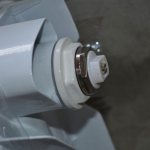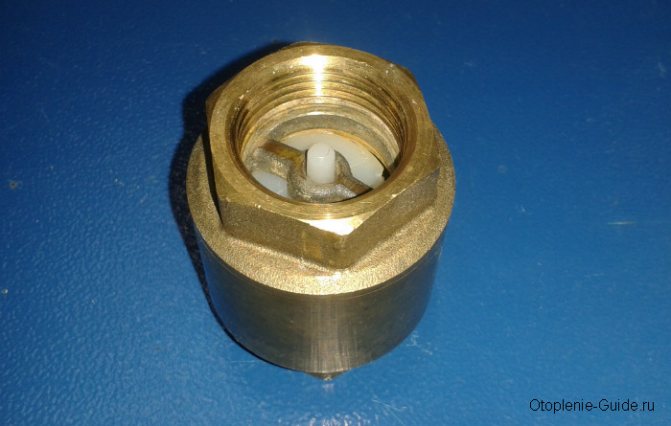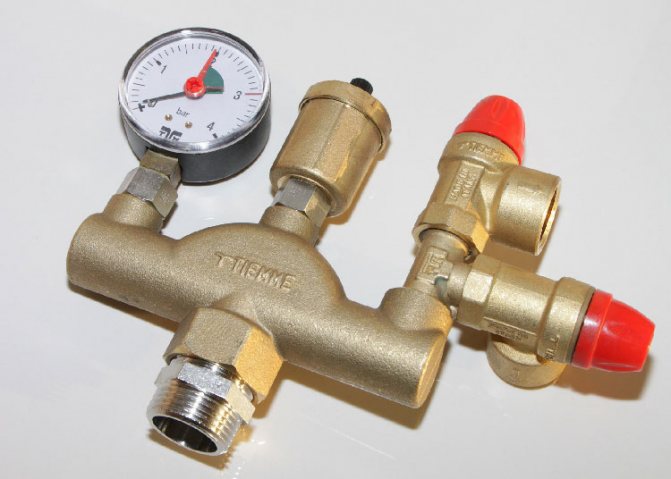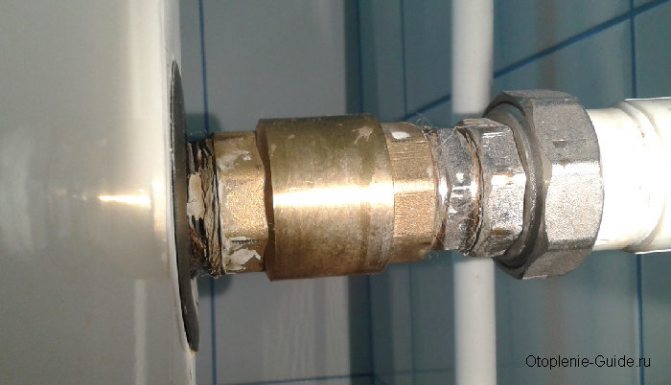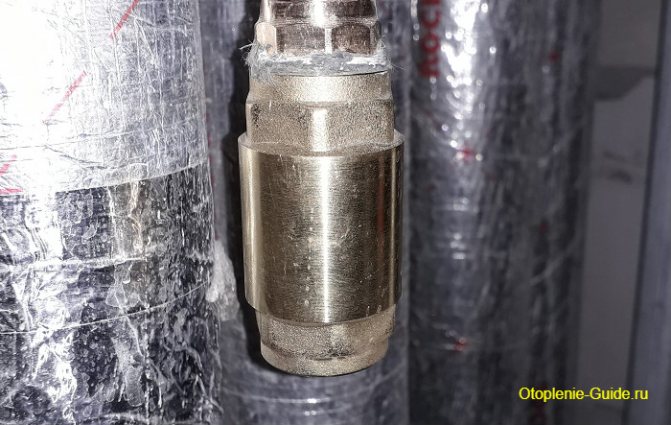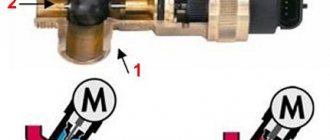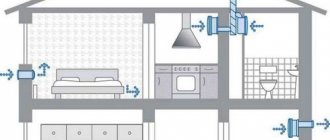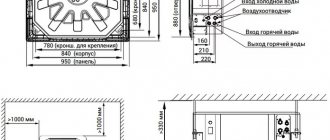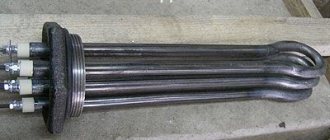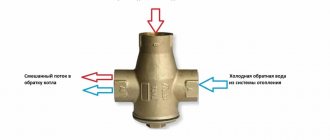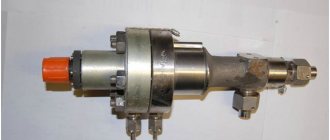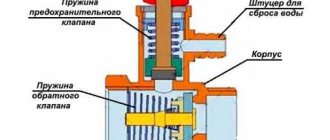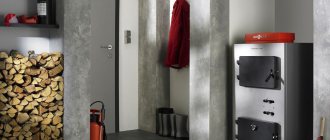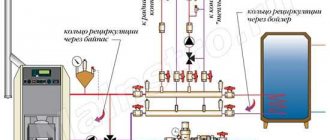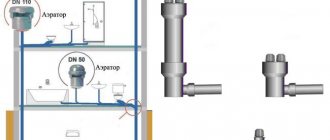What is forced circulation for?
The natural circulation of the coolant occurs according to physical laws: heated water or antifreeze rises to the top point of the system and, gradually cooling down, goes down, returning to the boiler. For successful circulation, it is necessary to strictly maintain the angle of inclination of the straight and return pipes. With a small length of the system in a one-story house, this is easy to do, and the height difference will be small.
For large houses and multi-storey buildings. such a system is most often unsuitable - it may form air jams, disturb circulation and, as a result, overheat the coolant in the boiler. This situation is dangerous and can cause damage to system components.
Therefore, a circulation pump is installed in the return pipe, immediately before entering the boiler heat exchanger, which creates the required pressure and water circulation rate in the system. At the same time, the heated coolant is promptly discharged into the heating devices, the boiler operates normally, and the microclimate in the house remains stable.
Diagram: elements of the heating system
- the system works stably in buildings of any length and number of storeys;
- you can use pipes of a smaller diameter than with natural circulation, which saves the cost of purchasing them;
- it is allowed to place pipes without a slope and lay them hidden in the floor;
- warm water floors can be connected to the forced heating system;
- stable temperature regime prolongs the life of fittings, pipes and radiators;
- it is possible to regulate the heating for each room.
Disadvantages of a forced circulation system:
- calculation and installation of the pump is required, connecting it to the mains, which makes the system volatile;
- the pump makes a noise during operation.
The disadvantages are successfully solved by the correct placement of the equipment: the pump is placed in a separate room of the boiler room next to the heating boiler and a backup power source is installed - a battery or a generator.
Valve installation location
There are points in the heating system where air is necessarily collected. So, Mayevsky's taps in the apartment should be installed on each radiator. In many modern radiator models, air bleed devices are installed at the manufacturing stage by the manufacturers themselves.
We recommend that you familiarize yourself with: Fittings for electrowelded pipes
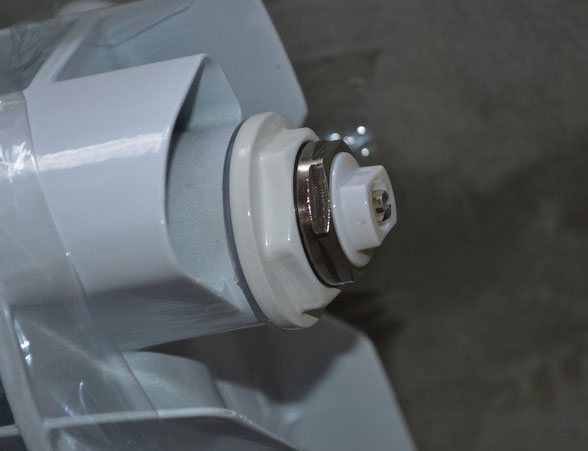
Note! If you have classic radiators, then the air valve should be installed in the upper part of it, which is located opposite the connection.
So you yourself can always control the normal operation of your heating batteries and not depend on the desire of the housing office employees or the mood of the neighbors from above.
Points for installing air relief valves:
- radiators, bathroom coil, upper part;
- the top point of the pipeline;
- heating boiler safety system in individual communications;
- for hydraulic branching;
- on the collectors of the common manifold;
- on any U-shaped loops in communications, at the top point;
- for expansion joints in plastic heating systems.
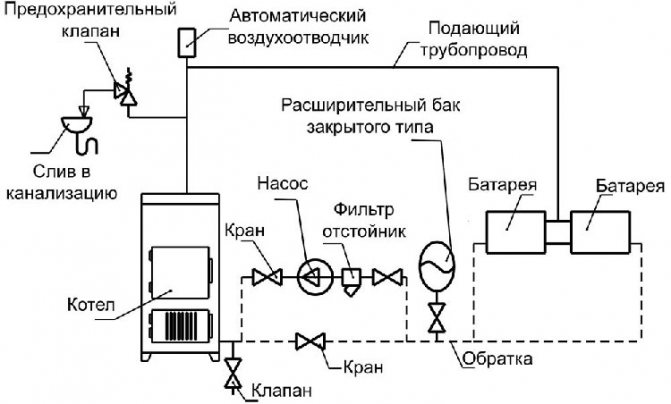

It should be understood that air always accumulates in the upper part of the communications. An air lock can arise in the bend of a plastic pipe if the installation was carried out incorrectly and there was a temperature deformation.
The easiest way to get rid of the plug in the pipeline permanently is to cut a tee into the pipe.On the free vertical branch of the tee (the diameter of which is selected accordingly), a valve is installed to release air.
The principle of operation of a gravity heating system
The principle of operation of heating looks simple: water moves through the pipeline, driven by the hydrostatic head, which appeared due to the different mass of heated and cooled water. Such a structure is also called gravity or gravity. Circulation is the movement of the cooled liquid in the batteries and the heavy liquid under the pressure of its own mass down to the heating element, and the displacement of the light heated water into the supply pipe. The system works when the natural circulation boiler is located below the radiators.
In open circuits, it communicates directly with the external environment, and excess air escapes into the atmosphere. The volume of water increased from heating is eliminated, the constant pressure is normalized.
Natural circulation is also possible in a closed heating system if it is equipped with an expansion vessel with a membrane. Sometimes open-type structures are converted into closed ones. Closed circuits are more stable in operation, the coolant does not evaporate in them, but they are also independent of electricity. What affects the circulating head
The water circulation in the boiler depends on the difference in density between the hot and cold liquid and on the height difference between the boiler and the lowest radiator. These parameters are calculated even before the installation of the heating circuit is started. Natural circulation occurs because the return temperature in the heating system is low. The coolant has time to cool down, moving through the radiators, it becomes heavier and, with its mass, pushes the heated liquid out of the boiler, forcing it to move through the pipes.
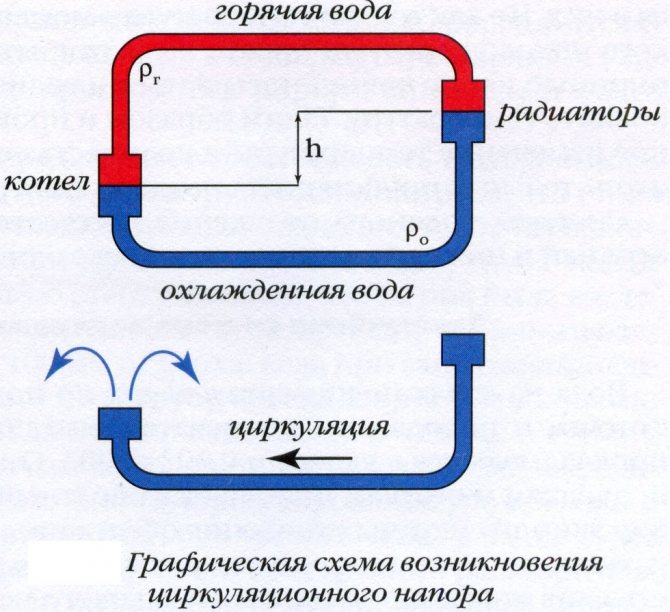

Boiler water circulation diagram
The height of the battery level above the boiler increases the pressure, helping the water to more easily overcome the resistance of the pipes. The higher the radiators are in relation to the boiler, the greater the height of the cooled return column and with the greater the pressure it pushes the heated water upward when it reaches the boiler.
Density also regulates the pressure: the more the water heats up, the less its density becomes in comparison with the return. As a result, it is pushed out with more force and the pressure increases. For this reason, gravity heating structures are considered self-regulating, because if you change the temperature of heating the water, the pressure on the coolant will also change, which means that its consumption will change.
During installation, the boiler should be placed at the very bottom, below all other elements, in order to ensure a sufficient head of the coolant.
Pipes for natural circulation systems
When choosing the diameter of the pipes, not only the size of the system and the number of radiators play a role, but also the material from which they are made, or rather, the smoothness of the walls. For gravitational systems, this is a very important parameter. The worst situation is with ordinary metal pipes: the inner surface is rough, and after use it becomes even more uneven due to corrosion processes and accumulated deposits on the walls. Therefore, such pipes take the largest diameter.
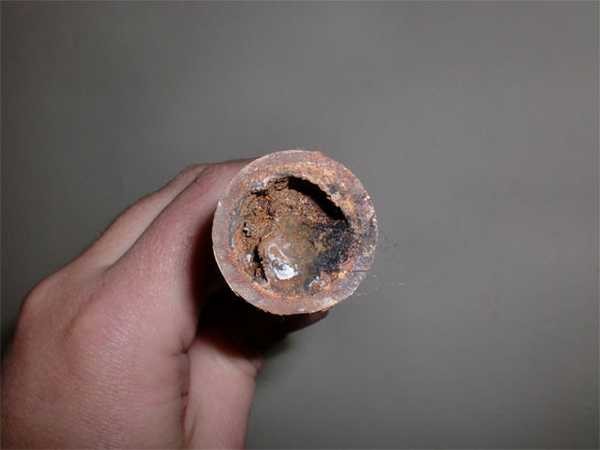

Steel pipes after a few years may look like this
From this point of view, metal-plastic and reinforced polypropylene are preferable. But in metal-plastic, fittings are used that significantly narrow the lumen, which can become critical for gravity systems. Therefore, reinforced polypropylene looks more preferable. But they have restrictions on the temperature of the coolant: the operating temperature is 70 ° C, the peak temperature is 95 ° C. For products made of special PPS plastic, the operating temperature is 95 ° C, the peak temperature is up to 110 ° C.So, depending on the boiler and the system as a whole, these pipes can be used, provided that these are high-quality branded products, and not a fake. Read more about polypropylene pipes here.
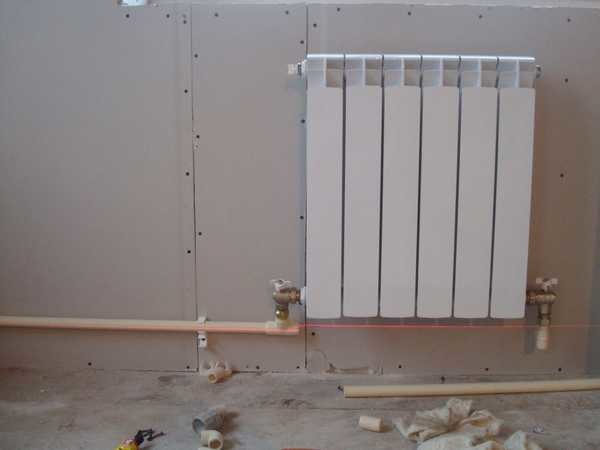

Metaloplastic and polypropylene can also be used for the installation of heating systems
But if you intend to install a solid fuel boiler. then no polypropylene can withstand such heat loads. In this case, either still use steel, or galvanized and stainless steel on threaded joints (do not use welding when installing stainless steel, since the seams leak very quickly)
Copper is also suitable (it is written about copper pipes here), but it also has its own characteristics and must be handled carefully: it will not behave normally with all coolants, and it is better not to use it in one system with aluminum radiators (they quickly collapse )
A feature of systems with natural circulation is that they cannot be calculated due to the formation of turbulent flows that cannot be calculated. They are designed based on experience and averaged, empirically derived norms and rules. Basically, the rules apply:
- raise the acceleration point as high as possible;
- do not narrow the supply pipes;
- supply a sufficient number of radiator sections.
Then another one is used: from the place of the first branch and each subsequent one is led with a pipe of a diameter smaller by a step. For example, a 2-inch pipe goes from the boiler, then from the first branch 1 ¾, then 1 ½, etc. The scrap is collected from a smaller diameter to a larger one.
There are several more features of the installation of gravitational systems. First, it is advisable to make pipes with a slope of 1-5%, depending on the length of the pipeline. In principle, with a sufficient temperature and altitude difference, horizontal wiring can also be made, the main thing is that there are no areas with a negative slope (inclined in the opposite direction), which, due to the formation of air jams in them, will block the movement of the water flow.


One-pipe gravity system with vertical distribution on two wings (contours)
The second feature is that an expansion tank and / or an air vent must be installed at the highest point of the system. The expansion tank can be open (the system will also be open) or membrane (closed). When installed open, there is no need to exhaust air; it collects at the highest point - in the tank and escapes into the atmosphere. When installing a membrane type tank, an automatic air vent is also required. With horizontal wiring, the "Mayevsky" taps on each of the radiators will not interfere - with their help it is easier to remove all air jams in the branch.
Installation diagram of gravity heating systems
Since the circulation of water in the heating system takes place without the participation of a pump, for the unimpeded flow of liquid through the highways, they must have a diameter larger than in a circuit where water circulation is forced. The gravity system functions by reducing the resistance that water has to overcome: the farther the pipe is from the boiler, the wider it is.
Water heating with natural circulation can have top or bottom wiring. When a two-pipe wiring is designed, heated water enters directly into each battery, and does not pass them alternately, as in a one-pipe scheme.
The upper wiring, in which the coolant first rises to the ceiling, and from there descends to the batteries, is best suited to carry out the installation of such a structure. If the layout is planned to be lower. then an accelerating circuit is constructed: a height difference at which the water from the boiler first goes up, where at the top of the pipeline it enters the expansion tank, and then it goes down to the heating radiators.
The higher the heater is located, the higher the pressure inside the pipeline. Therefore, the batteries on the upper floors often warm up better than those on the lower ones. Accordingly, if you make two-pipe heating with natural circulation, the batteries placed at the same level with the boiler or below do not warm up enough.
To avoid such a situation, the boiler room is deeply buried, providing a sufficiently high pressure for the coolant to pass through the pipes at the required speed. The boiler is placed in a basement, approximately 3 meters below the center of the lowest heating element. Pipes with hot water, on the contrary, are lifted up as much as possible, placing an expansion tank at the highest point of the structure, and then the water from the supply pipe goes down to the radiators.
Types of one-pipe system wiring
In a one-pipe system, there is no separation between a direct and a return pipe. The radiators are connected in series, and the coolant passing through them gradually cools down and returns to the boiler. This feature makes the system economical and simple, but requires setting the temperature regime and correct calculation of the power of the radiators.
A simplified version of a one-pipe system is only suitable for a small one-story house. In this case, the pipe passes through all radiators directly, without temperature control valves. As a result, the first batteries along the course of the coolant turn out to be much hotter than the last ones.
This layout is not suitable for extended systems. after all, the cooling of the coolant will be significant. For them, a single-pipe system "Leningradka" is used, in which the common pipe has adjustable branches for each radiator. As a result, the coolant in the main pipe is more evenly distributed throughout all rooms. The layout of a single-pipe system in multi-storey buildings is divided into horizontal and vertical.
Horizontal routing
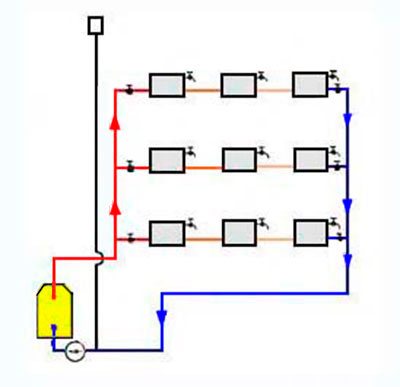

With horizontal routing, the straight pipe rises to the upper floor along the main riser. A horizontal pipe extends from it on each floor, passing sequentially along all the batteries on this floor.
They are combined into a return pipe and fed back to the boiler or boiler. Temperature control taps are located on each floor, and Mayevsky taps are on each radiator. Horizontal wiring can be performed both flow-through and according to the Leningradka system.
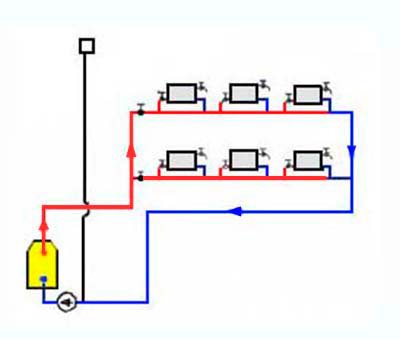

Vertical layout


With this type of wiring, the hot coolant rises to the uppermost floor or attic, and from there, along vertical risers, it passes through all floors to the lowest. There the risers are combined into a return line. A significant drawback of this system is uneven heating on different floors, which cannot be adjusted with a flow-through system.
The choice of a wiring system for a private house depends mainly on its layout. With a large area of each floor and a small number of storeys of the house, it is better to choose a vertical wiring, so you can achieve a more even temperature in each room. If the area is small, it is better to choose a horizontal layout, as it is easier to regulate. In addition, with a horizontal type of routing, you do not have to make unnecessary holes in the floors.
Video: one-pipe heating system
Flanged (coupling) ball check valve
In contrast to the above-described type of check valves, the ball valve has high hydraulic characteristics, which are provided by its design features.
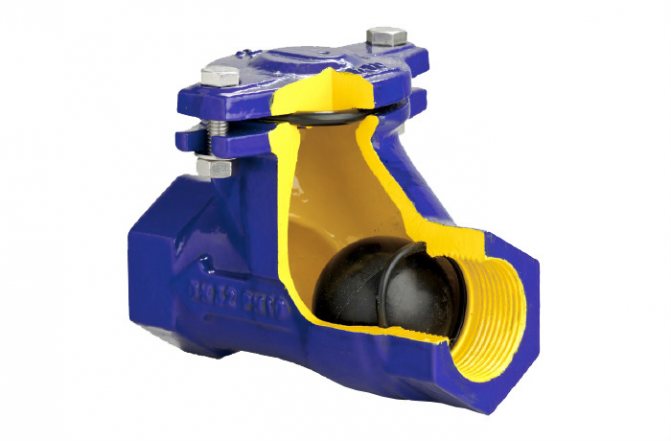

Pig-iron ball check valve for heating Zetkama V401 (Poland).
The basis of the design is a cast-iron or aluminum ball covered with a layer of rubber, which, when the coolant moves directly, is pushed into the upper part of the body, into a special niche.In case of stopping direct movement, the ball rolls under its own weight into the lower part of the body, blocking the movement of the coolant in the opposite direction.
The top of the cast iron valve body has a removable cast iron cover for quick service and repair. The cover is attached to the body with several bolts, and is equipped with an O-ring to avoid leakage.
This design imposes the following installation requirements:
- When installed horizontally, the "ball compartment" should be directed upwards, only in this case the ball will freely roll downwards;
- With vertical installation, the flow of the heating medium must move from bottom to top.
The principle of operation of the system with natural circulation
The heating scheme of a private house with natural circulation is popular due to the following advantages:
- Simple installation and maintenance.
- No need to install additional equipment.
- Energy independence - no additional electricity costs are required during operation. In the event of a power outage, the heating system continues to work.
The principle of operation of water heating, using gravity circulation, is based on physical laws. When heated, the density and weight of the liquid decreases, and when the liquid medium cools down, the parameters return to their original state.
At the same time, there is practically no pressure in the heating system. In heat engineering formulas, a ratio of 1 atm is taken. for every 10 m of the head of the water column. The calculation of the heating system of a 2-storey building will show that the hydrostatic pressure does not exceed 1 atm. in one-story buildings 0.5-0.7 atm.
Since the liquid increases in volume during heating, an expansion tank is required for natural circulation. The water passing through the boiler water circuit heats up, which leads to an increase in volume. The expansion tank should be located on the coolant supply, at the very top of the heating system. The task of the buffer tank is to compensate for the increase in liquid volume.
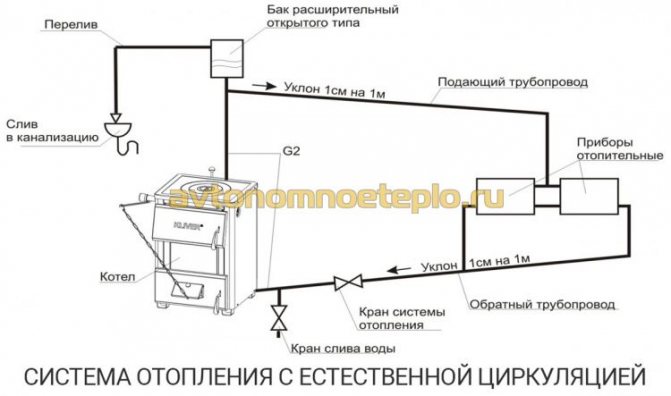

A self-circulation heating system can be used in private houses, making the following connections possible:
- Connection to underfloor heating - requires the installation of a circulation pump, only on the water circuit laid in the floor. The rest of the system will continue to work with natural circulation. After a power outage, the room will continue to be heated using installed radiators.
- Working with an indirect water heating boiler - connection to a system with natural circulation is possible, without the need to connect pumping equipment. For this, the boiler is installed at the top of the system, just below the closed or open air expansion tank. If this is not possible, then the pump is installed directly on the storage tank, additionally installing a check valve to avoid recirculation of the coolant.
In systems with gravitational circulation, the movement of the coolant is carried out by gravity. Due to natural expansion, the heated liquid rises up the booster section, and then, at a slope, "flows" through the pipes connected to the radiators back to the boiler.
Lift check valve
The design of this type of valve consists of a body (made of stainless steel, cast iron or bronze) with a flange or coupling connection and a removable cover on the thread, thanks to which a quick repair and cleaning of the valve is carried out. The locking mechanism consists of a brass (or stainless steel) butterfly valve with a spindle, which is held in the closed position by a steel spring. The use of a spring allows the lift valve to be mounted in any position.


Zetkama V277 cast iron lift check valve. Max. temperature up to + 200 ° C.
Note! In addition, there are models without a spring, in such valves, when the coolant starts to move in the opposite direction, the damper drops down under the weight of its own weight. Such models should only be installed horizontally with the cover facing up.
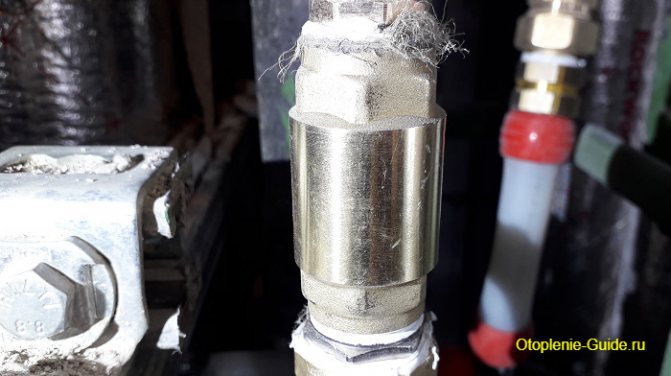

Section of the radiator heating system.
Increase in temperatures
Another factor is the difference between the density of cold and hot water. Let's note the following fact - heating with natural circulation belongs to the self-regulating type. Thus, if the temperature of water heating is increased, then its flow rate changes and the circulating head becomes higher.
Strong heating of the liquid contributes to a much faster circulation. But this only happens in a cold room: when the air temperature in them reaches a certain mark, the batteries will cool down much more slowly.
The density of both the water heated in the boiler and the water that has already entered the radiators will practically be equal. The pressure will decrease, the rapid circulation of water will be replaced by measured circulation within the system.


As soon as the temperature of the premises of a private house drops to a certain level again, this will serve as a signal to increase the pressure. The system will try to equalize the temperature conditions. To do this, you will have to restart the fast circulation process. This is where the ability for self-regulation comes from.
In short, the rule is the following - a one-time change in temperature and volume of water allows you to get the required heat output from batteries for heating rooms.
As a result, comfortable temperature conditions are maintained.
Scheme of action
The hot water heating system includes a boiler (water heater), return and supply pipelines, as well as heating equipment, an expansion tank and a safety valve. The liquid heats up to the desired temperature in the boiler and rises into the supply pipe and risers due to expansion.
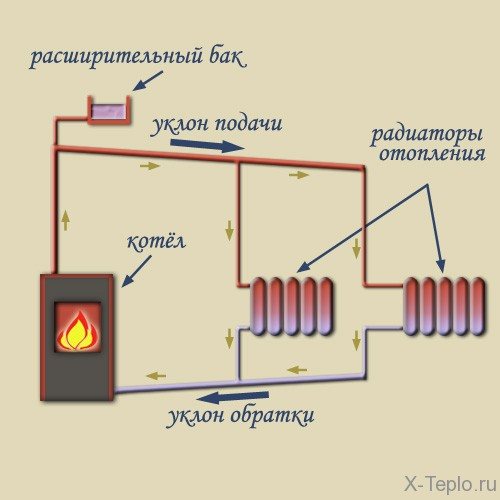

From there, it goes into heating equipment - batteries and radiators, to which it gives off some of the heat. Then the return pipe directs the water to the boiler, where it heats up again to the set temperature. The cycle repeats as long as the system is operational.
It is important to remember that horizontal pipes are mounted with a slope in relation to the movement of the working environment.
Lobe check valve
In most cases, they are used in boiler houses and large heating points with pipelines from DN50 and above.
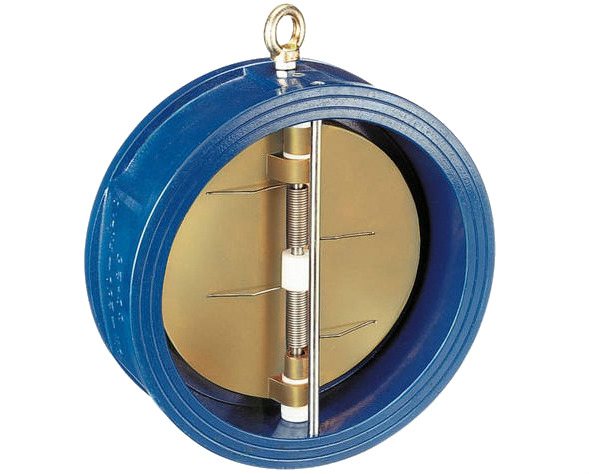

Lobe valve Ebro Armaturen (Germany) type DC, sizes from DN 50 to DN 300.
The valve body is available in cast iron or stainless steel. The locking mechanism consists of two petals (flaps) attached to a rod located in the center of the structure. The petals are kept closed by several torsion springs.
The disadvantages of a petal valve include "weak" hydraulics. This is due to the fact that the petals in the open position and the stem are in the center of the section, directly in the path of the coolant flow.
Design of forced circulation heating
Detailed home heating scheme
The primary task in the independent installation of water heating with a circulation pump is to draw up the correct scheme. To do this, you need a house plan, on which the location of pipes, radiators, valves and security groups is applied.
System calculation
At the stage of drawing up the diagrams, it is necessary to correctly calculate the pump parameters for the forced heating system of a private house. To do this, you can use special programs or do the calculations yourself. There are a number of simple formulas to help you calculate:
Where Рн is the rated power of the pump, kW, р is the density of the coolant, for water this indicator is 0.998 g / cm³, Q is the level of the coolant consumption, l, N is the required pressure, m.
Example program for calculating heating
To calculate the pressure indicator in the forced heating system of a house, it is necessary to know the total resistance of the pipeline and heat supply as a whole. Alas, it is almost impossible to do it yourself. To do this, you should use special software packages.
Having calculated the resistance of the pipeline in a hot water heating system with circulation, you can calculate the required pressure indicator using the following formula:
Where H is the calculated head, m, R is the resistance of the pipeline, L is the length of the largest straight section of the pipeline, m, ZF is the coefficient, which is usually 2.2.
Based on the results obtained, the optimal model of the circulation pump is selected.
If the calculated pump power indicators for a self-installed forced circulation heating system are large, it is recommended to purchase paired models.
Heating installation with circulation
Example of concealed installation of collector heating
Based on the calculated data, pipes of the required diameter are selected, and shut-off valves to them. However, the diagram does not show the way of installing the trunk. The pipelines can be installed in a hidden or open way. The first is recommended to be used only with full confidence in the reliability of the entire heating system of a private cottage with forced circulation.
It must be remembered that the quality of the components of the system will depend on its performance and performance. This is especially true for the material of manufacture of pipes and valves. In addition, for a two-pipe heating system with forced circulation, it is recommended to heed the advice of professionals:
- Installation of an emergency power supply for the circulation pump in the event of a power outage;
- When using antifreeze as a coolant, check its compatibility with the materials for the manufacture of pipes, radiators and boiler;
- According to the heating scheme of a house with forced circulation, the boiler should be located at the lowest point of the system;
- In addition to the pump power, it is necessary to calculate the expansion tank.
Circulation heating installation technology is no different from the standard
It is important to take into account the features of the contour house - the material for making the walls, its heat losses. The latter directly affects the power of the entire system.
Analytics of the parameters of heating systems with forced circulation will help to form an objective opinion about it:
What it is
If a system with forced circulation requires a pressure difference created by a circulation pump or provided with a connection to a heating main, then the picture is different. Natural circulation heating uses a simple physical effect - the expansion of the liquid when heated.
If we ignore the technical subtleties, the basic scheme of work is as follows:
- The boiler heats up a certain amount of water. So, of course, it expands and, due to the lower density, is displaced upward by the colder mass of the coolant.
- Having risen to the top point of the heating system, the water, gradually cooling down, traces a circle around the heating system by gravity and returns to the boiler. At the same time, it gives off heat to the heating devices and by the time it is again at the heat exchanger, it has a higher density than at the beginning. Then the cycle is repeated.
Useful: of course, nothing prevents you from including a circulation pump in the circuit.In normal mode, it will provide faster water circulation and uniform heating, and in the absence of electricity, the heating system will operate with natural circulation.


Pump operation in a natural circulation system.
The photo shows how the problem of interaction between the pump and the natural circulation system is solved. When the pump is running, the check valve is activated and all the water flows through the pump. It is worth turning it off - the valve opens, and water circulates through the thicker pipe due to thermal expansion.
Varieties of check valve devices
On the modern market, check valves of various types are offered, each of which differs both in its design and technical characteristics.
Disc type check valves
The design of such devices includes a body, which can be made of brass or stainless steel, and a locking mechanism. The latter consists of the following elements:
- a metal or plastic butterfly valve, which ensures that the flow of the transported medium is shut off if it starts to move in the wrong direction;
- a sealing gasket, which serves for a more tight fit of the butterfly valve to the seat;
- steel spring, which ensures that the valve is in the closed state if the flow of the working medium moves in the wrong direction.


The principle of the disc check valve
The spring-loaded disc check valves, which are optimally suited for equipping domestic heating systems and do not require regular maintenance, have the following advantages:
- compact size and light weight;
- affordable cost.
However, disc-type spring valves also have disadvantages:
- When using this type of check valves in heating systems, significant hydraulic resistance is created, which is especially critical when a ground source heat pump is used in such systems. That is why in such cases it is necessary to perform preliminary calculations.
- Spring disc type check valves, which are maintenance-free, cannot be repaired.


Poppet check valve with brass disc
Ball check valves
In contrast to the disc valve, the ball valve has better hydraulic characteristics, which is the reason for its high popularity among consumers. The locking element of this device, as its name implies, is a ball covered with a rubber layer, which can be made of cast iron or aluminum. The principle by which a check-type ball valve works is quite simple.
- When the coolant moves through the ball valve in the required direction, the shut-off element - the ball - under the pressure of the working medium rises to the upper part of the device, completely opening the through hole.
- In the event that the pressure of the working medium flow decreases or it starts to move in the wrong direction, the ball, under the influence of its own weight, descends into a special niche, closing the passage opening and blocking the movement of the working medium flow through the device.
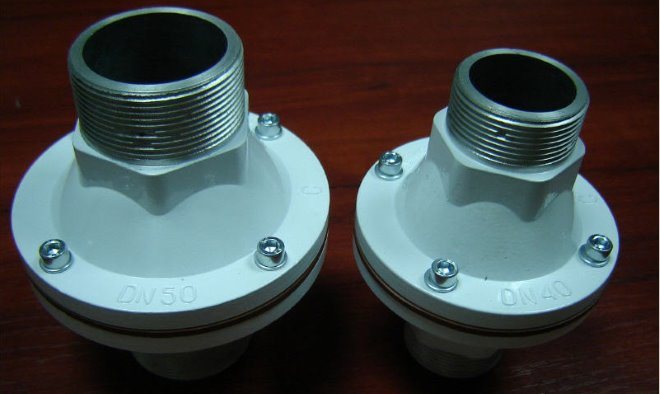

Ball type heating check valve
A ball check valve is usually equipped with a cover that is attached to its body with a few bolts. The presence of such a cover makes it possible to quickly and easily perform repair and maintenance of the shutter, if necessary.
When installing check ball valves on pipelines for various purposes, the following nuances must be taken into account.
- The ball valve should be positioned with the cover up when installed on a horizontal section of the pipeline so that the ball in the working compartment of the device has the ability to freely roll into its lower part.
- When installing a check ball valve in a vertical section of the pipeline, it must be borne in mind that the flow of the working medium passing through the device must move in the direction from bottom to top.


The operation of this valve is ensured by a ball that moves inside the body under the action of a coolant.
Lobe type check valves
The petal check valve, the locking elements of which are two spring-loaded flaps (petals), located on a special axis, is installed on the pipeline systems of large boiler stations and heating points. One of the most significant disadvantages of petal type check valves is poor hydraulics. This is due to the fact that their flaps, even when open, create a significant obstacle to the flow of the working medium moving through the pipeline.
The petal valve devices include a gravitational check valve, the shut-off element of which is one flap, fixed on a special axis and having the ability to rotate freely. The gravity check valve works according to the following principle.
- The sash opens under the pressure of the working medium flow.
- If the pressure of the flow of the working medium drops or it starts to move in the wrong direction, the sash, under the influence of its own gravity, lowers, closing the device.
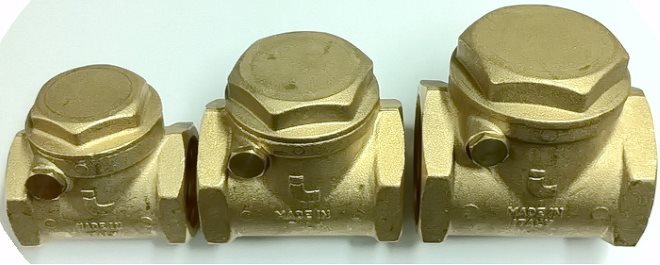

There is no spring in the horizontal petal valve for heating, which makes it possible to operate the valve even when the water is moving by gravity
Lift type check valves
The closing element of such devices is a spring-loaded spool that moves on a special axis. Some models are not equipped with a spring, they can only be used for installation in vertical pipe sections. Like ball valves, rotary check valves are equipped with a bonnet that allows them to be repaired and serviced if required.
During installation, lift-type spring check valves must be installed with the cover facing up, which will provide access to their interior in cases where they need to be repaired or maintained.


Lift type check valve device
Boiler for gravity systems
Since such circuits are mainly needed for a heating device independent of electricity, the boilers must also operate without the use of electricity. These can be any non-automated units, except for pellet and electric ones.
Most often, solid fuel boilers work in systems with natural circulation. They are all good, but in many models the fuel burns out quickly. And if there are severe frosts outside the window, and the house is not sufficiently insulated, then in order to maintain an acceptable temperature at night, you have to get up and throw up fuel. This situation is especially common where firewood is used. The way out is to buy a long-burning boiler (non-volatile, of course). For example, in Lithuanian solid fuel boilers Stropuva, under certain conditions, firewood burns for up to 30 hours, and coal (anthracite) for up to several days. The characteristics of the Sandle boilers are slightly worse: the minimum burning time for firewood is 7 hours, for coal - 34 hours. The German company Buderus, the Czech Viadrus and the Polish-Ukrainian Wikchlach, as well as the Russian ones, Ogonyok, have boilers without automation and pumps.
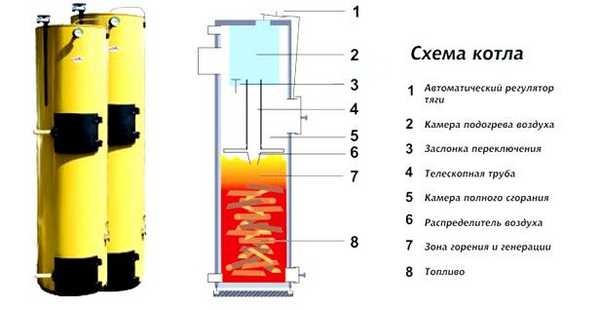

Non-volatile long-burning boiler Stropuva
There are Russian-made non-volatile gas boilers, for example, "Conord". which are produced in Rostov-on-Don. They can be used in natural circulation systems. The same plant produces non-volatile universal boilers "Don", which are also suitable for operation without electricity.Floor-standing gas boilers of the Italian company Bertta - model Novella Autonom and some other units of European and Asian manufacturers operate in systems with natural circulation.
The second way, which will help to increase the time between fireboxes, is to increase the inertia of the system. For this, heat accumulators (TA) are installed. They work well with solid fuel boilers, which do not have the ability to regulate the intensity of combustion: excess heat is diverted to a heat accumulator, in which energy is accumulated and consumed as the coolant in the main system cools. The connection of such a device has its own characteristics: it must be located on the supply pipeline at the bottom. Moreover, for efficient heat extraction and normal operation, it is as close to the boiler as possible. However, this solution is far from the best for gravitational systems. They slowly enough go to the normal circulation mode, but they are self-regulating: the colder it is in the room, the more the coolant cools down passing through the radiators. The greater the difference in temperatures, the more the density difference is obtained and the faster the coolant moves. And the installed TA makes the heating more inertial, and it takes much more time and fuel to accelerate. True, the heat is given off longer. In general, it's up to you to decide.


To stabilize the temperature in the system, a heat accumulator is installed
About the same problems with natural circulation stove heating. Here the role of the heat accumulator is played by the furnace array itself and it also requires a lot of energy (fuel) to accelerate the system. But in the case of using TA, the possibility of its exclusion is usually provided, and in the case of a furnace, this is unrealistic.
From the laws of physics
Suppose that in radiators and a boiler the temperature of the liquid changes in jumps along the central axes: the upper parts contain hot liquid, and the lower ones contain cold.
Hot water is less dense, which reduces its weight compared to cold water. As a result, the heating system consists of two communicating vessels, closed with each other, in which liquid moves from top to bottom.
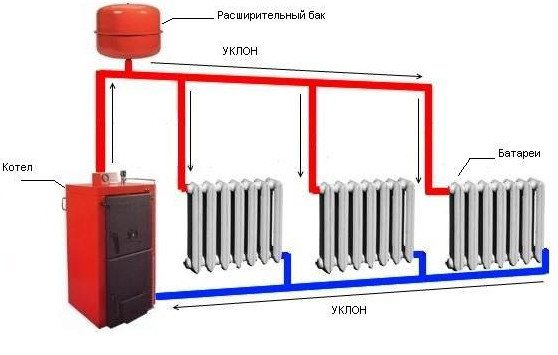

A high pillar formed by cooled water with a large weight, upon reaching the radiators, pushes the low pillar. As a result, the hot liquid is pushed and circulation occurs.
Swing check valve
Available in flanged or coupled versions. Rotary valve body and removable cover, available in cast iron, bronze or stainless steel. A stainless steel disc serves as a locking element, which rises upward under the pressure of the direct flow of the coolant.
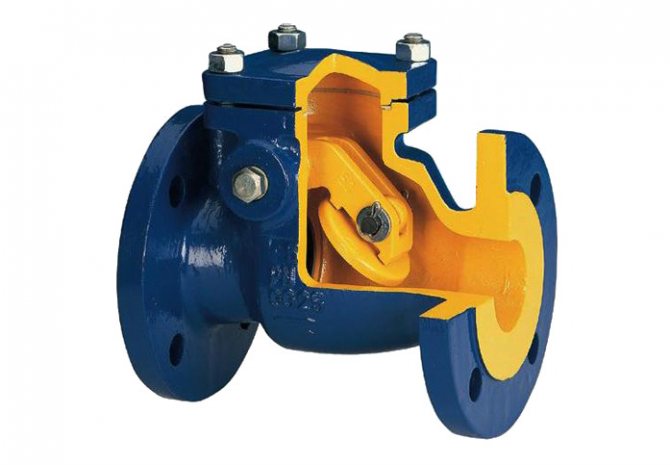

Cast iron swing check valve Zetkama V302. Max. temperature up to + 300 ° C.
Due to the full opening of the bore, the rotary valve has a high hydraulic performance.
Like ball check valves, rotary valves are also mounted horizontally with the cover up, and vertically so that the flow of the coolant moves from bottom to top.
Types of gravity circulation heating systems
Despite the simple design of a water heating system with self-circulation of the coolant, there are at least four popular installation schemes. The choice of the type of wiring depends on the characteristics of the building itself and the expected performance.
To determine which scheme will be workable, in each individual case it is required to perform a hydraulic calculation of the system, take into account the characteristics of the heating unit, calculate the pipe diameter, etc. Professional help may be required when performing calculations.
Closed system with gravity circulation
In the EU countries, closed systems are the most popular among other solutions. In the Russian Federation, the scheme has not yet received widespread use.The principles of operation of a closed-type water heating system with a pumpless circulation are as follows:
- When heated, the coolant expands, water is displaced from the heating circuit.
- Under pressure, the liquid enters the closed diaphragm expansion tank. The design of the container is a cavity divided into two parts by a membrane. One half of the reservoir is filled with gas (most models use nitrogen). The second part remains empty for filling with a coolant.
- When the liquid is heated, enough pressure is created to push the membrane and compress the nitrogen. After cooling down, the reverse process takes place, and the gas squeezes the water out of the tank.
Otherwise, closed-type systems work like other natural circulation heating schemes. The disadvantages are the dependence on the volume of the expansion tank. For rooms with a large heated area, you will need to install a spacious container, which is not always advisable.
Open system with gravity circulation
The open-type heating system differs from the previous type only in the design of the expansion tank. This scheme was most often used in older buildings. The advantages of an open system are the ability to independently manufacture containers from scrap materials. The tank usually has a modest size and is installed on the roof or under the ceiling of the living room.
The main disadvantage of open structures is the ingress of air into pipes and heating radiators, which leads to increased corrosion and rapid failure of heating elements. Airing the system is also a frequent "guest" in open-type circuits. Therefore, radiators are installed at an angle; Mayevsky taps are required to bleed air.
One-pipe system with self-circulation
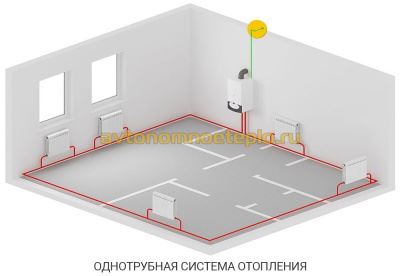

This solution has several advantages:
- There is no pair piping under the ceiling and above the floor level.
- Funds are saved on the installation of the system.
The disadvantages of this solution are obvious. The heat transfer of heating radiators and the intensity of their heating decreases with distance from the boiler. As practice shows, a one-pipe heating system of a two-story house with natural circulation, even if all slopes are observed and the correct pipe diameter is selected, is often altered (by installing pumping equipment).
Self-circulation two-pipe system
The two-pipe heating system in a private house with natural circulation has the following design features:
- The supply and return pass through different pipes.
- The supply line is connected to each radiator through an inlet branch.
- The second line connects the battery to the return line.
As a result, a two-pipe radiator-type system offers the following advantages:
- Even distribution of heat.
- No need to add radiator sections for better heating.
- It is easier to adjust the system.
- The diameter of the water circuit is at least one size smaller than in single-pipe circuits.
- Lack of strict rules for installing a two-pipe system. Small deviations with respect to slopes are allowed.
The main advantage of a two-pipe heating system with lower and upper wiring is simplicity and, at the same time, efficiency of the design, which makes it possible to neutralize errors made in calculations or during installation work.
How the device works
An air valve (or several) is installed in the heating system, in places most likely for the accumulation of air bubbles. This prevents the formation of a large congestion, the heating works smoothly.
We recommend that you familiarize yourself with: Dimensions and types of PVC sewer pipes and adapters for their connection
Mayevsky crane
Such devices were named after the name of their developer.The Mayevsky crane has a thread and dimensions for a pipe with a diameter of 15 mm or 20 mm. It is arranged simply:
- In the body of the valve body, 2 through holes are made, which, in the open position of the Mayevsky crane, are connected to the heating system.
- These holes are sealed with a taper threaded screw.
- Air is discharged through a small (2 mm) opening directed upwards.
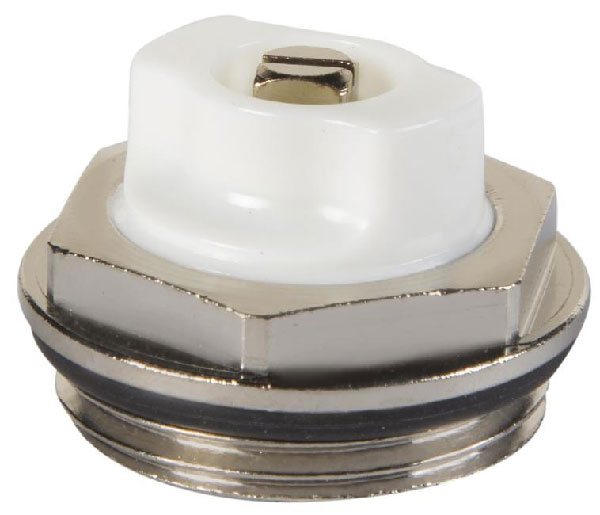

In order to bleed air from the system, unscrew the screw 1.5-2 turns. Air blows out with a whistle as communications are under pressure. The end of the airlock outlet is characterized by a drop in pressure and the appearance of water.
Note! The Mayevsky crane is a simple and reliable device for bleeding air accumulations. It does not clog or break because it has no moving parts. Its design is simple and reliable.
On the market, you can find several varieties of the Mayevsky crane, which are the same in design, but differ in the way of adjusting the locking screw. There are:
- with a comfortable handle for unscrewing by hand;
- with a regular head for a flat screwdriver;
- with a square head for a special key.
For an adult, the principle of unscrewing the locking screw does not matter. However, in a home with children, it is safer to use devices that must be unscrewed with a special device. Having unscrewed the usual tap with a comfortable handle, the child can scald with boiling water.
Automatic faucet
The automatic air relief valve is based on the principle of a float chamber, the design includes:
- vertical case with a diameter of 15 mm;
- float inside the body;
- a spring-loaded valve with a cover, which is connected and regulated by a float.
The automatic air valve for the heating system works without human intervention. Normally, when there is no air in the system, the float is pressed against the valve cover by the pressure of the liquid filler. At the same time, the lid is tightly closed.
We recommend that you familiarize yourself with: Advantages and disadvantages of cast iron fittings
As air accumulates in the valve body, the float goes down. As soon as it drops to the critical level, the spring valve opens and bleeds out the air. Under the pressure of the carrier in the system, the space is again filled with liquid. The float rises to close the spring valve cover.
When there is no coolant in the communications, the float lies at the bottom of the valve. As the system fills, air leaves the tap in a continuous flow until the coolant reaches the float.
Note! A small amount of air is constantly present under the cover of the automatic valve. This is normal and does not affect work in any way.
A distinction is made between the following configurations of automatic air valves for heating:
- with vertical air discharge;
- with lateral air discharge (through a special jet);
- with bottom connection;
- with corner connection.
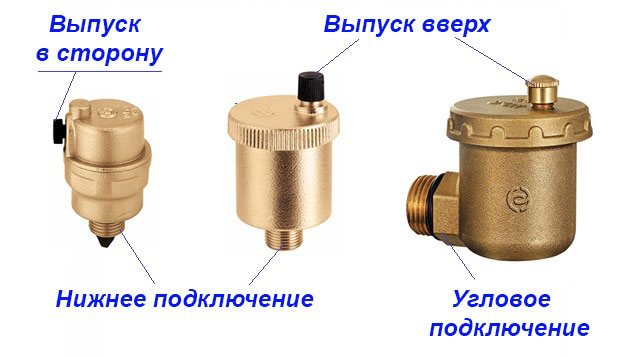

For the layman, the design features of an automatic crane do not matter. However, for a professional, there is a difference in choosing between devices.
It is considered that:
- a device with a nozzle and a side hole is more reliable in operation than an automatic valve with a vertical air discharge;
- The bottom-connected valve is more effective at trapping air bubbles than the side-mounted valve.
If the design of the Mayevsky crane has not undergone changes for many years, then the device of automatic valves is constantly being improved and supplemented.
Manufacturers offer automatic valves with additional devices:
- with a membrane to protect against water hammer;
- with a shut-off valve, for the convenience of dismantling the device during the heating season;
- mini valves.
Note! The disadvantage of an automatic valve is that it gets dirty quickly.Limescale, debris clog the internal, moving parts of the device. This leads to a weakening of the efficiency of its work or complete failure.
Automatic air valves for heating need frequent inspection and cleaning. The undoubted advantages of these devices include the ability to install them in hard-to-reach places.
Power calculation
The effective heat output of the boiler is calculated in the same way as in all other cases.
By area
The simplest way is the calculation of the area of the room recommended by SNiP. 1 kW of thermal power should fall on 10 m2 of the area of the room. For the southern regions, a coefficient of 0.7 - 0.9 is taken, for the middle zone of the country - 1.2 - 1.3, for the regions of the Far North - 1.5-2.0.
Like any rough calculation, this method neglects many factors:
- The height of the ceilings. It is far from being the standard 2.5 meters everywhere.
- Heat leaks through the openings.
- The location of the room inside the house or against external walls.
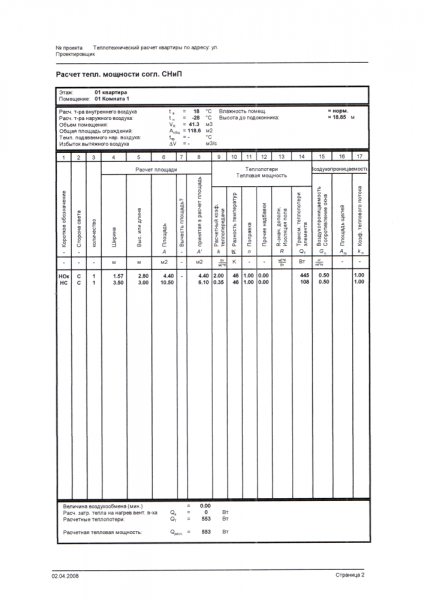

All calculation methods give large errors, therefore, the thermal power is usually included in the project with a certain margin.
By volume, taking into account additional factors
A more accurate picture will be given by another calculation method.
- The basis is a thermal power of 40 watts per cubic meter of air volume in the room.
- Regional coefficients apply in this case as well.
- Each standard size window adds 100 watts to our estimate. Each door is 200.
- The location of the room against the outer wall will give a coefficient of 1.1 - 1.3, depending on its thickness and material.
- A private house with a street below and above is not warm neighboring apartments, is calculated with a coefficient of 1.5.
However: this calculation will be VERY approximate. Suffice it to say that in private houses built using energy-saving technologies, a heating capacity of 50-60 watts per SQUARE meter is included in the project. Too much is determined by heat leaks through walls and ceilings.
findings
So, It is important to know
:
- When choosing a device, you should take into account the pressure and temperature of the coolant. In private houses, water with a temperature of 95 degrees is circulated through pipes at a pressure of approximately 3 bar. If there is a heating network, you need to find out these parameters.
- The installation of shut-off valves must be carried out in accordance with the requirements specified in the technical data sheet of the product.
- The pump responsible for the circulation of water must be located in the circuit up to the shut-off valves.
- The connection method is selected depending on the pressure in the network. The coupling valve is used at a pressure not exceeding the 16 bar mark, the flanged valve is used above this mark.
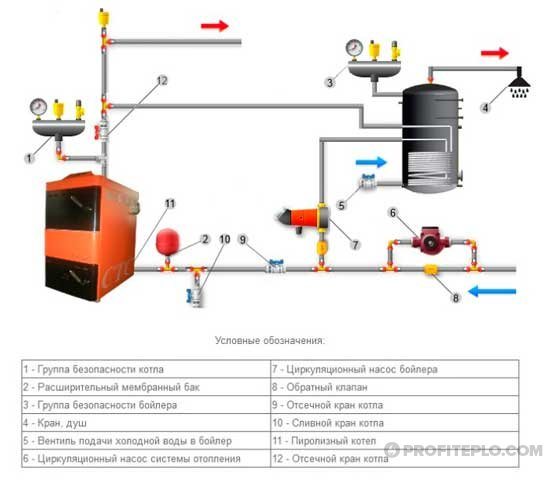

Check valve in the heating system
A non-return valve is an indispensable component of any heating system. Under some operating conditions, it is responsible for the uninterrupted and trouble-free operation of the equipment, under others, it increases the efficiency of work. The success of the solution of the assigned tasks depends on the correct choice of the device. Do you have doubts? Seek professional help. Otherwise, there is a risk of unforeseen financial costs associated with the repair of the boiler and the restoration of the heating system.
Related videos:
Advantages of installing a two-pipe system
When designing water heating with forced circulation for a private house, they choose, based on the material capabilities of the owner, a one-pipe or two-pipe scheme. The one-pipe system is cheaper, easier to install, and the two-pipe system is more efficient in operation. When installing a horizontal two-pipe heating system, three pipeline layouts are possible: dead-end, associated and collector.
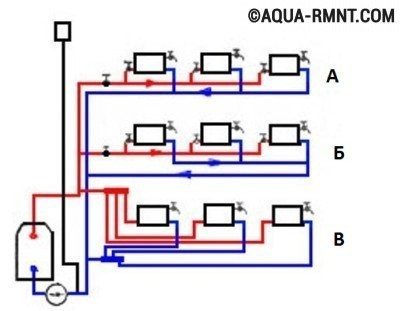

Three schemes for arranging a horizontal two-pipe heating system in a private house: A) dead-end; B) passing; B) collector (beam)
Immediately, we note that the last one has the greatest efficiency, namely the collector piping. However, its implementation increases the consumption of materials, as well as the complexity of the installation work.
